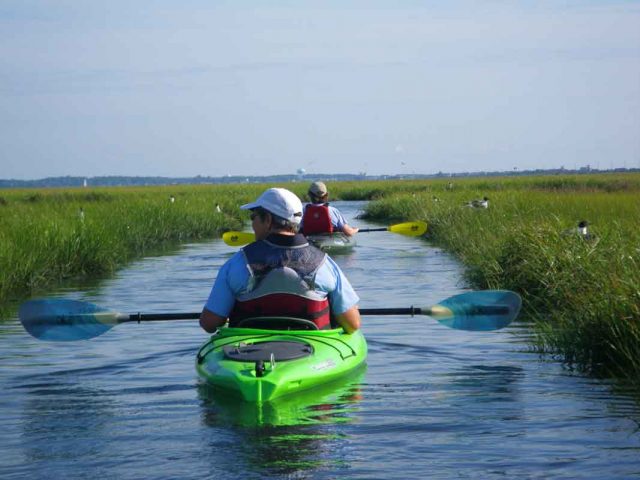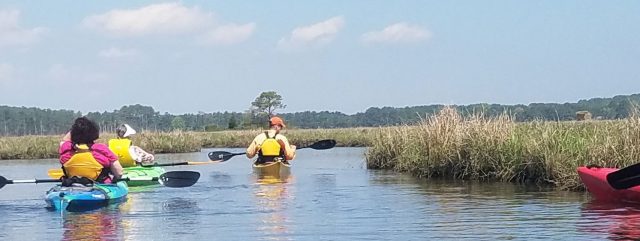“I think the salt marsh turned brown last night,” Mitch said as we were driving to Assateague yesterday.
This year, with the summer-like fall we’ve been experiencing, the inevitable seasonal changes in the area flora took us by surprise. But no matter what the thermometer is saying, the days are getting shorter. And that means that the salt marsh has to prepare for winter.

In this mid October tour the smooth cordgrass is going dormant.
The most prevalent grass in our marshes is smooth cordgrass (Spartina Alterniflora). While it flowers July through September, in mid to late August it goes to seed. When that happens it grows fast. “In 2-3 days it doubles in height,” says Mitch. “It grows from about one and a half feet to three feet virtually overnight.” This can be problematic for Coastal Kayak guides. “We look at the amount of grass above the water to determine the tide level. When the grass is so tall, it looks like the water is low so we assume we’ll need to do the low tide route.”

This is the vivid green cordgrass of the summer.
Smooth cordgrass is a perennial, meaning it comes back year after year. At this time of year, as it goes dormant, the leaves turn brown. During storms the dead leaves bend and break off. Insects and other little critters eat the dying vegetation helping the decomposition process. Some of this decomposed matter stays within the marsh grasses building up soil levels while some of it goes out with the tides. These nutrients carried into the water feed nurseries of young fish and shellfish the following spring.
Isn’t it amazing? This finely tuned process continues over and over needing nothing from us. In fact, the more we leave the salt marshes alone, the more it protects and feeds us. One acre of salt marsh produces up to 10 tons of cordgrass every year!
In the spring, as the roots come out of dormancy, the new green stalks push out the old dead ones. More decomposition, more building up, more feeding the next generation of critters in our bay. So as you’re heading up Route 1 holding back tears seeing the bright summer colors fade away, think of all the good that beautiful brown marsh grass is doing.

In this early spring tour the new green grass is pushing out the dead grass.
~by Jenifer Adams-Mitchell
Facts for this post found: https://www.edc.uri.edu/restoration/html/gallery/plants/smooth.htm and https://ncfscience.org/2017/01/26/the-winter-life-of-the-salt-marsh/
